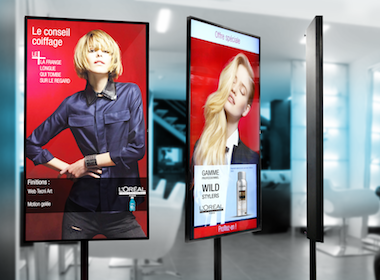This blog is an iteration of Chapter 3 of our free guide, Getting Started with Digital Signage.
Digital signage displays can do a lot, but they can’t defy gravity. They need mounts in order to stay in place. Welcome to the world of digital signage mounts.
Mounting your digital signage displays is the most aesthetically and practically sound way to secure them in place. Mounts also provide functionality by allowing you to easily adjust a display’s position. They’re a must-have, especially with so many of today’s consumer TVs and professional displays lacking a stand.

A few types of digital signage mounts exist, each allowing different levels of adjustment and having its pros and cons. This guide will introduce seven types of mounts: flat mounts, tilt mounts, full-motion mounts, ceiling mounts, kiosk mounts, tablet mounts and freestanding mounts. We’ll also explain VESA compliance and clear up any confusion over digital signage mounts versus regular TV mounts. You’ll have more than enough information to decide which mount best fits your digital signage needs.
First of all, you’ll frequently see mounts described as VESA-compliant. What does this mean?
VESA Compliance
VESA stands for Video Electronics Standards Association, a technical standards organization for the digital display industry. VESA-compliant mounts fit VESA’s family of standards for display mounting. The system ensures compatibility of displays and mounts regardless of manufacturer.
As a consumer or digital signage user, there’s no need to know the technical details of VESA compliance. The vast majority of today’s displays and mounts fit VESA standards.
You may also be wondering what makes something a digital signage mount, and if you can use a consumer TV mount for digital signage.
Digital Signage Mounts vs. TV Mounts – Is There a Difference?
We’ve told you before that you can use consumer TVs for digital signage, even though commercial/professional displays also exist. The case of digital signage mounts versus TV mounts is similar.
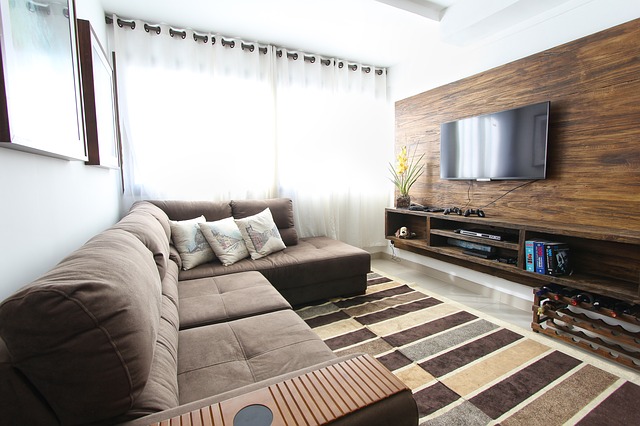
Some so-called digital signage mounts are interchangeable with consumer TV mounts, and some are not. Flat, tilt, full-motion and ceiling mounts are fitting for both digital signage and home entertainment purposes, whether or not they’re referred to as digital signage mounts. Other mounts, however, like kiosk, tablet or freestanding mounts, are designed for digital signage.
Just know that when you’re shopping online for mounts, you can absolutely use consumer TV mounts for your digital signage displays.
Now let’s explore seven types of digital signage mounts.
Flat Mounts
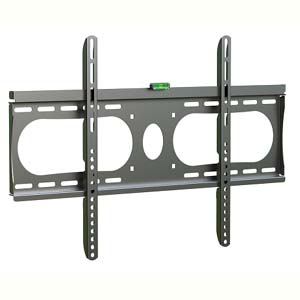
Cost: $20-$100+
Best for: Flat surfaces; controlled lighting with no glare concerns; low budgets; a clean, minimalist look
Flat mounts, also called “fixed” or “flush” mounts, are the most basic type of digital signage mount. They allow you to mount a display to a wall or other flat surface and position it flush against the wall. They do not allow any tilting or other adjustment of the display once it’s mounted. They provide a very minimalist, clean look, but keep in mind that you won’t be able to adjust the display to remove glare. They also offer only about one or two inches of space between the display and the wall, meaning you may have to detach the display from the mount to plug or unplug cables in the back.
Tilt Mounts
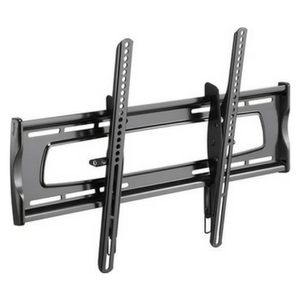
Cost: $25-$150+
Best for: Avoiding glare; displays above eye level
Tilt mounts look similar to flat mounts, but they allow you to tilt the display on a vertical axis. These mounts are useful for avoiding glare, or adjusting displays that are above eye level. They’re a little more expensive than flat mounts, but offer slightly more range of motion.
Full-Motion Mounts
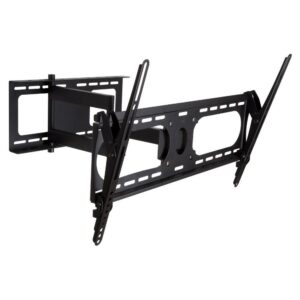
Cost: $30-$400+
Best for: Larger budgets; placing a display in a corner or window
Also referred to as “TV arm mounts”, “retractable TV mounts” or “articulating TV mounts”, full-motion mounts offer the most range of motion. You can adjust them vertically, side-to-side (horizontally) or forwards and backwards. The range of motion also makes it easier to access the cables and ports on the back of your display.
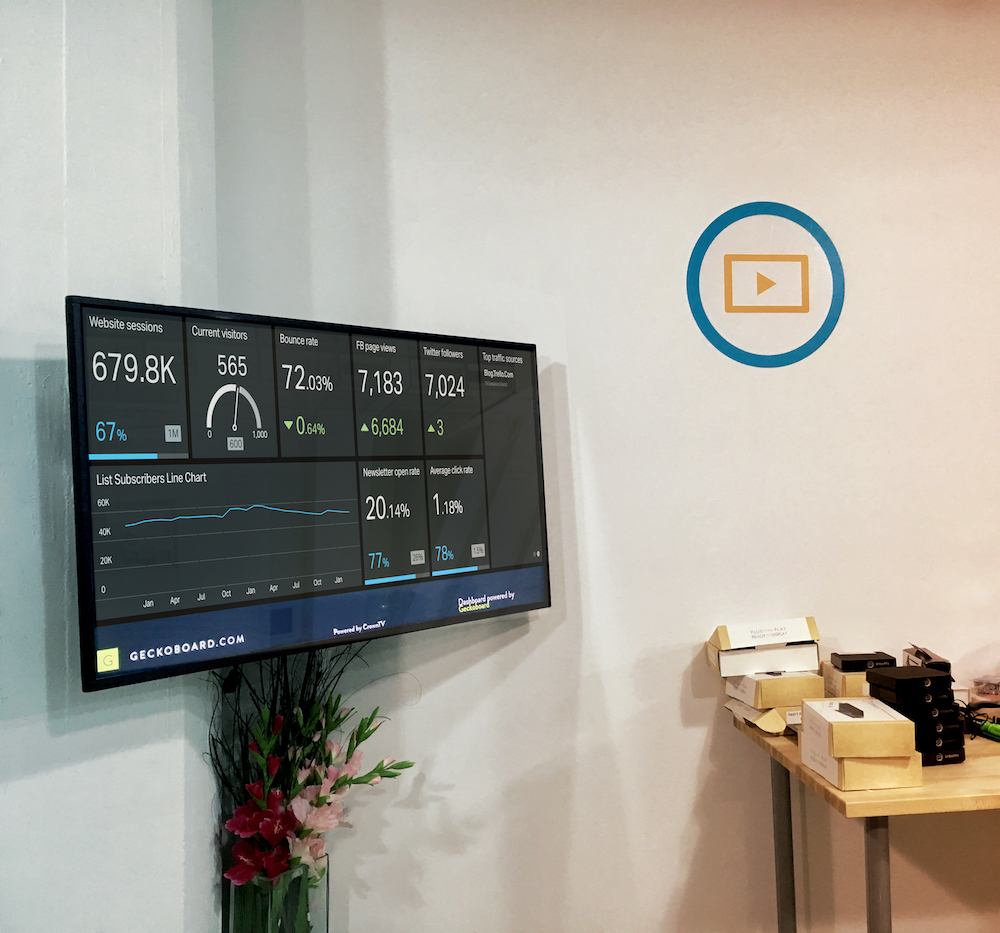
The biggest advantage of full-motion mounts is they enable you to put a display in places like a corner or a window, without a floor stand. Just install the mount on a nearby flat surface, then position the display as desired.
Ceiling Mounts
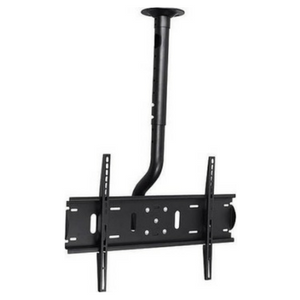
Cost: $40-$350+
Best for: Limited floor or wall space; placing a display in a corner, window or middle of a room; placing screens side-by-side or back-to-back with one mount; 360-degree viewing; a professional look
Ceiling mounts, as you can guess, attach to a ceiling. They mostly appear in commercial settings — notably retail stores — and not so much in consumers’ homes. These mounts look very clean and professional without taking up any floor or wall space. They’re ideal for operations where space is an issue. Many of them allow for vertical tilting as well as 360 degree horizontal rotation.
Ceiling mounts allow you to hang a display almost anywhere, like a corner, window or middle of the room. Some ceiling mounts are designed for multiple screens, allowing you to place screens side-by-side or back-to-back using a single mount. If you want to get really fancy, you can even arrange displays in a circle or square and enable 360-degree viewing.
Kiosk Mounts
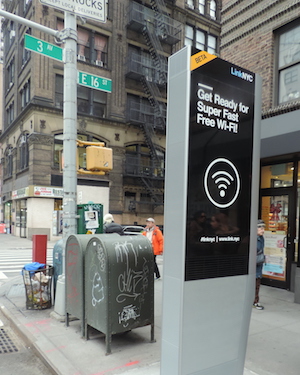
Cost: $700-$3000+
Best for: Touchscreen displays; concealing everything but a digital display’s screen
You’ve probably seen kiosk mounts at your local mall displaying a directory or some advertisements. They’re common in public areas that receive a lot of foot traffic, due to their sturdiness and clean, professional look. The mount may come by itself or with a digital display already inside of it.
Tablet Mounts
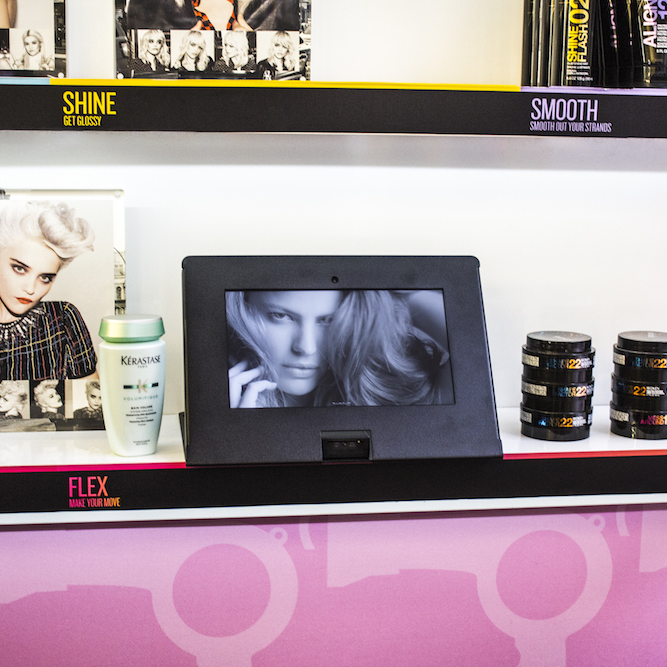
Cost: $25-$200+
Best for: Resting a tablet on a flat surface; placing a tablet within a shelf
Tablet mounts allow you to place a tablet on a flat surface and have it stand up on its own. They’re popular for placing tablets at points-of-sale, like near checkout. They can also make tablets fit seamlessly within retail shelving, right alongside products. Some tablet mounts, like the ones CrownTV manufactures, have built-in added features like facial recognition or barcode scanners.
Freestanding Mounts
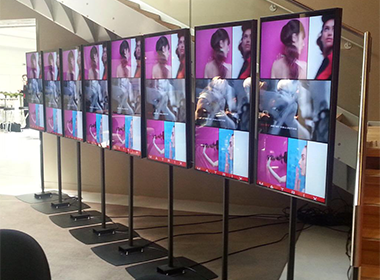
Cost: $70-$2000+
Best for: Concealing the back of a display; a clean, professional look; windows; any placement where the back of a display is visible to customers
Freestanding digital signage mounts conceal the back of a display, making it completely flat and allowing it to be visible to customers. You can place a freestanding mount in a storefront window and not worry about the back being seen by customers, because it looks clean and attractive.
CrownTV manufactures freestanding mounts that also allow you to place a printed poster on the back. Contact us for more information on purchasing these mounts.
Mounts are the physical foundation of your digital signage, so it’s important to make sure they serve your digital signage needs. To discuss your needs in more detail with a digital signage specialist, contact CrownTV.

